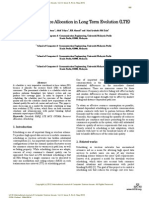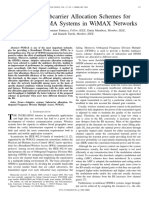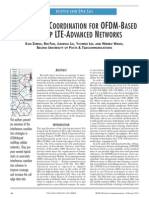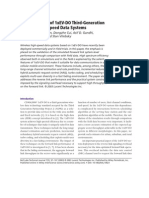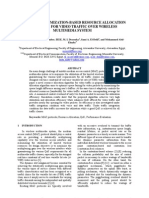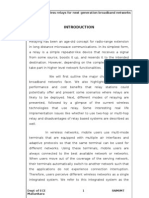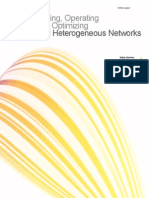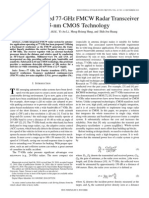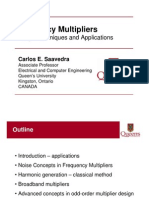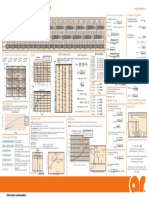Implementation of Adaptive Modulation and Coding Technique Using
Uploaded by
Roger DiazImplementation of Adaptive Modulation and Coding Technique Using
Uploaded by
Roger DiazInternational Journal of Scient if ic & Engineering Research Vol ume 2, Issue 5, May-2011 1
ISSN 2229-5518
IJSER 2011
http://www.ijser.org
Implementation of Adaptive Modulation and
Coding Technique using
Sami H. O. Salih, Mamoun M. A. Suliman
AbstractDifferent order modulations combined with different coding schemes, allow sending more bits per symbol, thus
achieving higher throughputs and better spectral efficiencies. However, it must also be noted that when using a modulation
technique such as 64-QAM with less overhead bits, better signal-to-noise ratios (SNRs) are needed to overcome any
Intersymbol Interference (ISI) and maintain a certain bit error ratio (BER). The use of adaptive modulation allows wireless
technologies to yielding higher throughputs while also covering long distances. The aim of this paper is to implement an
Adaptive Modulation and Coding (AMC) features of the WiMAX and LTE access layer using SDR technologies in Matlab. This
papper focusing on the physical layer design (i.e. Modulation), here the various used modulation type will be implemented in a
single Matlab function that can be called with the appropriate coefficients. A comparison with the hardware approaches will be
made in terms of SNR vs. BER relation.
Index Terms. Adaptive Modulation and Coding (AMC), Cognitive Radio (CR), LTE, Software Defined Radio (SDR), WiMAX.
1 INTRODUCTION
The growth i n the use of the i nformation networks
l ead to the need for new communi cation networks
wi th hi gher data rates. The tel ecommunicati on i ndus-
try i s al so changi ng, wi th a demand for a greater range of
servi ces, such as vi deo conferences, or appli cations wi th
mul ti medi a contents. The i ncreased rel i ance on computer
networki ng and the Internet has resul ted i n a wi der de-
mand for connecti vi ty to be provi ded "any where, any
ti me", leading to a rise in the requi rements for hi gher ca-
paci ty and hi gh reli abi l i ty broadband wirel ess access
Broadband wi rel ess Access (BWA) tel ecommunicati on
systems.
BWA i ntensi vel y focused i n the l ast few years. Thus,
vari ous new technologi es wi th hi gh transmi ssi on abil i ti es
have been desi gned. The BWA has become the best way
to meet escal ati ng busi ness demand for rapi d Internet
connecti on and i ntegrated "tri pl e pl ay" servi ces. That i s
the very base of the HSPA, Wi MAX, and LTE concept: a
wi rel ess transmi ssion i nfrastructure that al l ows a fast
depl oyment as well as l ow mai ntenance costs.
The emergent demand of al l types of servi ces, not onl y
voi ce and data but al so mul ti medi a servi ces, ai ms for the
desi gn of increasingl y more intell igent and agile commu-
ni cati on systems, capabl e of provi di ng spectral l y effi ci ent
and fl exi bl e data rate access. These systems are abl e to
adapt and adjust the transmi ssi on parameters based on
the l i nk quali ty, i mprovi ng the spectrum effi ci ency of the
system, and reachi ng, i n thi s way, the capaci ty li mi ts of
the underl yi ng wi rel ess channel .
Li nk adaptati on techni ques, often referred to as adap-
ti ve modul ation and codi ng (AMC), are a good way for
reaching the cited requirements. They are designed to
track the channel variations, thus changi ng the modul a-
ti on and codi ng scheme to yi el d a hi gher throughput by
transmi tti ng wi th hi gh i nformati on rates under favorabl e
channel condi ti ons and reduci ng the i nformation rate i n
response to channel degradation.
2 BWADEVELOPMENT ROADMAP
2.1 Preface
The current Wi MAX revi si on i s based upon IEEE802.16e-
2005, approved i n December 2005. It i s a suppl ement to
the IEEE802.16-2004. [1] Thus, IEEE 802.16e-2005 i m-
proves by:
Addi ng support for mobi l i ty
Scal i ng of the Fast Fouri er transform (FFT) to the
channel bandwi dth i n order to keep the carri er
spaci ng constant across di fferent channel band-
wi dths (typi call y 1.25 MHz, 5 MHz, 10 MHz or 20
MHz
Advanced antenna diversi ty schemes, and hybri d
automati c repeat-request (HARQ)
Adaptive Antenna Systems (AAS) and MIMO
technology
Denser sub-channel i zation, thereby i mprovi ng i n-
door penetrati on
Introduci ng Turbo Codi ng and Low-Densi ty Pari -
ty Check (LDPC)
Introduci ng downl i nk sub-channeli zati on, al l ow-
i ng admi ni strators to trade coverage for capaci ty
or vi ce versa
Addi ng an extra QoS cl ass for real ti me appli ca-
ti ons
T
Sami H . O . Sal i h i s a l ect u r er at t he dept . of El ect r on i cs E n gi n eer i n g, Su -
dan U n i v er si t y of Sci en ce an d T ech n ol ogy ( SU ST ) .C cu r r en t l y he i s
PhD .st u den t i n t el ecomm u n i cat i on en gi n eer i n g i n SU ST , P.O BO X
11111- 2869, E- mai l :sami @su st ech.edu
M amou n M .A . Su l i man i s an A ssoci at e Pr of essor at t he dept . of El ect r on i cs
En gi n eer i n g, Su dan U n i v er si t y of Sci en ce an d T echn ol ogy , Su dan , E-
mail :mamounsul iman@yahoo.com.
International Journal of Scient if ic & Engineering Research Vol ume 2, Issue 5, May-2011 2
ISSN 2229-5518
IJSER 2011
http://www.ijser.org
In the other hand, Long Term Evol ution (LTE) i s the
l atest standard i n the 3rd Generati on Partnershi p Project
(3GPP), mobi l e network technol ogy tree that produced
the GSM/ EDGE and UMTS/ HSPA network technol o-
gi es.[1][2]
The LTE speci fi cati on provi des downl i nk peak rates of
at l east 100 Mbps, an upl i nk of at l east 50 Mbps and RAN
round-tri p ti mes of l ess than 10 ms. LTE supports scal abl e
carri er bandwi dths, from 1.4 MHz to 20 MHz and sup-
ports both frequency di vi si on dupl exi ng (FDD) and ti me
di vi sion dupl exi ng (TDD).
The mai n advantages wi th LTE are hi gh throughput,
l ow l atency, pl ug and pl ay, FDD and TDD i n the same
pl atform, an i mproved end-user experi ence and a si mpl e
archi tecture resul ti ng i n l ow operati ng costs. LTE wil l
al so support seaml ess passi ng to cel l towers wi th ol der
network technol ogy such as GSM, cdmaOne, UMTS, and
CDMA2000. The next step for LTE evol uti on i s LTE Ad-
vanced and is currentl y bei ng standardi zed i n 3GPP Re-
l ease 10. [3]
The most i mportant si mi l ari ty between LTE and Wi -
MAX i s orthogonal frequency division mul ti pl ex (OFDM)
si gnali ng. Both technol ogi es al so empl oy Vi terbi and tur-
bo accel erators for forward error correcti on. From a chi p
desi gner's perspecti ve, that makes the extensi ve reuse of
gates hi ghl y l i kel y i f one had to support both schemes i n
the same chi p or chi p-set. From a software defi ned radi o
(SDR) perspecti ve, the opportuni ty i s even more enti ci ng.
Fl exi bi l i ty, gate reuse and programmabi l i ty seem to be
the answers to the WiMAX-LTE mul ti mode chal l enge.
2.2 Hypothesis of AMC
In traditional communication systems, the transmission is
designed for the "worst case" channel scenario thus, coping
with the channel variations and still delivering an error rate
below a specific limit. Adaptive transmission schemes, how-
ever, are designed to track the channel quality by adapting
the channel throughput to the actual channel state. These
techniques take advantage of the time-varying nature of the
wireless channel to vary the transmitted power level, symbol
rate, coding scheme, constellation size, or any combination
of these parameters, with the purpose of improving the link
average spectral efficiency (bits/s/Hz).
3 SYSTEM DESIGN
3.1 Preface
Most BWA support variety of modulation and coding
schemes and allows for the scheme to change on a burst-by-
burst basis per link, depending on channel conditions. Cur-
rent systems contains separate hardware channel for each
Modulation/Coding scheme. The more intelligent approach
is to design single soft defined circuit for BPSK, QPSK,
16QAM, and 64QAM based on SDR then design a cognitive
engine (CE) to determine which profile to load and operate.
Following is a list of the various modulation and coding
schemes supported by WiMAX and LTE.
Both WiMAX and LTE support a vari ety of modul ati on
and codi ng schemes and al l ows for the scheme to change
on a burst-by-burst basi s per l i nk, dependi ng on channel
condi ti ons. Usi ng the channel quali ty feedback i ndicator,
the mobi l e can provi de the base stati on wi th feedback on
the downl i nk channel quali ty. For the upli nk, the base
stati on can esti mate the channel qual i ty, based on the re-
cei ved si gnal qual i ty.
For exampl e, when a user gets cl oser to a cell si te, the
number of channels wi l l i ncrease and the modul ati on can
al so change to i ncrease bandwi dth. At l onger ranges,
modul ati ons l i ke QPSK (whi ch offer robust l i nks but l ow-
er bandwi dth) can gi ve way at shorter ranges to 64 QAM
(which are more sensi tive li nks, but offer much higher
bandwi dth). Each subscri ber i s l i nked to a number of sub-
channel s that obvi ate mul ti -path i nterference. The upshot
i s that cel l s shoul d be much l ess sensi ti ve to overl oad and
cel l si ze shri nkage duri ng the l oad than before. Ideal l y,
customers at any range shoul d receive sol i d QoS wi thout
drops that 3G technol ogy may experi ence.
TABLE 1
MODULATION/CODING SCHEMES SUPPORTED BY WIMAX [1]
Fig. 1. BWA System Development.
Fig. 2. AMC Cell
International Journal of Scient if ic & Engineering Research Vol ume 2, Issue 5, May-2011 3
ISSN 2229-5518
IJSER 2011
http://www.ijser.org
3.2 System Architecture
3.2.1 Basic Wimax
The model for the WiMAX is build from the standard
documents [1, 2] as follow;
3.2.2 Cognitive Engin
When the basic system successfully built and tested, a cog-
nitive engine (CE) must develop to automatically direct the
SDR to load and execute the appropriate profile. The CE
refer to predefined polices, while continuously sensing the
channel situation. Then, perform its logic to pick up the suit-
able configuration to execute it in the SDR system.
4 ADAPTIVE COMMUNICATION SYSTEM
4.1 AMC Architecture
The function of AMC is based on SDR-CR combination.
The receiver evaluate received packets (i.e. SNR or BER) to
estimate the Channel Quality Indictor (CQI) module, then
feedback the transmitter to reconfigure itself for the next
packet send.
4.2 AMC System Performance
The performance of AMC highly depends on the accurate
channel estimation at the receiver and the reliable feedback
path between that estimator and the transmitter on which the
receiver reports channel state information (CSI). In order to
assure a high-quality implementation the next steps must be
followed:
4.2.1 Channel Quality Estimation
The transmitter requires an estimate of the expected channel
conditions for the next transmission interval. Since this
knowledge can only be gained by prediction from past chan-
nel quality estimations, the adaptive system can only operate
efficiently in an environment with relatively slowly-varying
channel conditions. Therefore, the delay between the quality
estimation and the actual transmission in relation to the
maximal Doppler frequency of the channel is crucial for the
system implementation since poor system performance will
result if the channel estimate is obsolete at the time of
transmission.
4.2.2 Parameter adaptation
The choice of the appropriate modulation and coding mode
to be used in the next transmission is made by the transmit-
ter, based on the prediction of the channel conditions for the
next time interval. An SNR threshold such that it guarantees
a BER below the target BER (BER0), is defined by the sys-
tem for each scheme whenever the SNR is above the SNR
threshold.
4.2.3 Feedback Mechanism
Once the receiver has estimated the channel SNR, converted
it into BER information for each mode candidate, and, based
on a target BER, selected the mode that yields the largest
throughput while remaining within the BER target bounds, it
has to feed back the selected mode to the transmitter in order
that the adaptation can be performed.
However, the chal l enge associ ated wi th adaptive
modul ati on and codi ng i s that the mobi l e channel i s ti me-
varyi ng, and thus, the feedback of the channel i nforma-
ti on becomes a l i mi ti ng factor. Therefore, the assumpti on
of a sl owl y-varyi ng as well as a rel i abl e feedback channel
i s necessary i n order to achi eve an accurate performance
of the AMC scheme. In thi s way, no del ay or transmi ssi on
error can occur i n the feedback channel so that no di scre-
pancy between the predi cted and the actual SNR of the
next frame appears. Moreover, the recei ver must al so be
i nformed of whi ch demodulator and decodi ng parame-
ters to employ for the next recei ved packet.
5 SIMULATION RESULTS
5.1 Functionality
A single function the can give different modulation order
from BPSK to M-QAM (M= 2n, where n = 2,4,6,...) imple-
mented in Matlab. The function called with the modulation
order and the SNR in dB as input, then its plot the constella-
Fig. 3. BWA System Components
Fig. 4. Cognitive Mechanism
Fig. 5. Adaptive System
International Journal of Scient if ic & Engineering Research Vol ume 2, Issue 5, May-2011 4
ISSN 2229-5518
IJSER 2011
http://www.ijser.org
tion and calculates the BER.
5.2 BER vs. SNR
BER is the number of error bits occurs within one second in
transmitted signal. BER defined mathematically as follow;
B E R =
Numbcr oI BIts wIth Error
TotaI Numbcr oI BIts TransmItcd
(1)
When the transmi tter and receivers medium are good
i n a parti cular ti me and Si gnal -to-Noise Rati o i s hi gh, and
then Bi t Error rate i s very l ow. In our thesis si mul ati on we
generated random si gnal when noi se occurs after that we
got the val ue of Bi t error rate.
S N R =
SIgnaI Powcr
NoIsc Powcr
= [
SIgnaI AmpIItudc
NoIsc AmpIItudc
2
(2)
6 CONCLUSION
The function implemented in this paper demonstrates the
ability of converge AMC concepts in a single Matlab file.
Tests show that all measured can be compared with the
hardware model in terms of functionality and system per-
formance. This component can be reused against a defined
standard, IEEE 802.1 6e, LTE, or other BWA. The second
part of the paper (Part II) will implement other system com-
ponent related to coding both for source and channel. In the
future this model can be expanded to include the compo-
nents of the upper layers and a complete end to end BWA
system could be built.
REFERENCES
[1] IEEE 802.16-2006: "IEEE Standard for Local and Metropol i tan
Area Networks - Part 16: Ai r Interface for Fi xed Broadband
Wi rel ess Access Systems".
[2] ETSI TS 102 177 Version 1.3. 1, February 2006, "Broadband Ra-
di o Access Networks (BRAN); Hi per MAN; Physi cal (PHY)
Layer"
[3] Practi cal Appl i cati ons for Wi rel ess Networks, Pari s, 10 October,
2006, l ET Workshop 2006.
[4] Dougl as H. Morai s, UMTSs LTE Webcast, Adroi t Wi rel ess
Strategi es, 16 Feb. 2010
[5] Muhammad Nadeem Khan, Sabi r Ghauri , The Wi MAX
802.16e Physical Layer Model ,Uni versity of West Engl and.
[6] Sami H. O., Mamoun M. A., Software Defi ned Radi o Ap-
proaches on Wi MAX Access Layer Desi gn , SUST, September
2009.
[7] Matthew Sherman, IEEE Standards Supporti ng Cogniti ve
Radi o and Networks, Dynami c Spectrum Access, and Coexi s-
tence , El ectroni cs & I ntegrated Sol uti ons, Jul y, 2008.
[8] Kuo-Hui Li , PhD, IEEE 802.16e-2005 Ai r Interface Overvi ew ,
Wi MAX Sol uti ons Di vi si on, Intel Mobi l i ty Group, June 05,
2006.
Fig. 4. AMC Constalation Diagrams
Fig. 4. Simulation BER vs. SNR
You might also like
- Adaptive Modulation Based MC-CDMA Systems For 4G Wireless Consumer ApplicationsNo ratings yetAdaptive Modulation Based MC-CDMA Systems For 4G Wireless Consumer Applications9 pages
- Queue Based Congestion Control Protocol On Wireless Sensor NetworksNo ratings yetQueue Based Congestion Control Protocol On Wireless Sensor Networks6 pages
- Downlink Resource Allocation in Long Term Evolution (LTE) : KeywordsNo ratings yetDownlink Resource Allocation in Long Term Evolution (LTE) : Keywords6 pages
- Performance Analysis of The Link-Adaptive Cooperative Amplify-And-Forward Relay Networks With Opportunistic Relaying StrategyNo ratings yetPerformance Analysis of The Link-Adaptive Cooperative Amplify-And-Forward Relay Networks With Opportunistic Relaying Strategy19 pages
- Adaptive Modulation and Coding Scheme With Intra-And Inter-Cell Mobility For HSDPA SystemNo ratings yetAdaptive Modulation and Coding Scheme With Intra-And Inter-Cell Mobility For HSDPA System8 pages
- Connection Admission Grooming in PCE Based Architecture Incorporating Dynamic Fiber State Information With Combined RWANo ratings yetConnection Admission Grooming in PCE Based Architecture Incorporating Dynamic Fiber State Information With Combined RWA10 pages
- Evolving WCDMA: Tomas Hedberg and Stefan ParkvallNo ratings yetEvolving WCDMA: Tomas Hedberg and Stefan Parkvall8 pages
- The 3g Long-Term Evolution Radi Interface PDFNo ratings yetThe 3g Long-Term Evolution Radi Interface PDF5 pages
- Adaptive Subcarrier Allocation Schemes For Wireless Ofdma Systems in Wimax NetworksNo ratings yetAdaptive Subcarrier Allocation Schemes For Wireless Ofdma Systems in Wimax Networks9 pages
- Queue-Aware Adaptive Resource Allocation For OFDMA Systems Supporting Mixed ServicesNo ratings yetQueue-Aware Adaptive Resource Allocation For OFDMA Systems Supporting Mixed Services7 pages
- Improving Quality of Service Using Ofdm Technique For 4th Generation NetworkNo ratings yetImproving Quality of Service Using Ofdm Technique For 4th Generation Network6 pages
- Frame Structure Design and Analysis For Millimeter Wave Cellular SystemsNo ratings yetFrame Structure Design and Analysis For Millimeter Wave Cellular Systems31 pages
- 1V DSP in Wireless Communication SystemsNo ratings yet1V DSP in Wireless Communication Systems4 pages
- I C Ofdm-B M Lte-A N: Nterference Oordination For Ased Ultihop Dvanced EtworksNo ratings yetI C Ofdm-B M Lte-A N: Nterference Oordination For Ased Ultihop Dvanced Etworks10 pages
- A Seminar Report: Department of Electronics & CommunicationsNo ratings yetA Seminar Report: Department of Electronics & Communications7 pages
- An Adaptive Cross-Layer Design For Multiservice SchedulingNo ratings yetAn Adaptive Cross-Layer Design For Multiservice Scheduling9 pages
- A Combined MAC and Physical Resource Allocation Mechanism in IEEE 802.16e NetworksNo ratings yetA Combined MAC and Physical Resource Allocation Mechanism in IEEE 802.16e Networks5 pages
- Alternating Minimization Algorithms For Hybrid Precoding in Millimeter Wave MIMO SystemsNo ratings yetAlternating Minimization Algorithms For Hybrid Precoding in Millimeter Wave MIMO Systems16 pages
- What Are LAPD and LAPD ?: Time Diversity Is Used in Digital Communication Systems To Combat That The TransmissionsNo ratings yetWhat Are LAPD and LAPD ?: Time Diversity Is Used in Digital Communication Systems To Combat That The Transmissions8 pages
- Resource Allocation Algorithms For Q S Optimization in Mobile W Max NetworksNo ratings yetResource Allocation Algorithms For Q S Optimization in Mobile W Max Networks15 pages
- Introduction To Cellular Networking and Rethinking Mobile ArchitecturesNo ratings yetIntroduction To Cellular Networking and Rethinking Mobile Architectures31 pages
- Radio Resource Management and Allocation in Ieee 802.16/ Wimax SystemsNo ratings yetRadio Resource Management and Allocation in Ieee 802.16/ Wimax Systems115 pages
- Performance of 1xEV-DO Third-Generation Wireless High-Speed Data SystemsNo ratings yetPerformance of 1xEV-DO Third-Generation Wireless High-Speed Data Systems11 pages
- Optical CDMA Transmission System SimulationsNo ratings yetOptical CDMA Transmission System Simulations40 pages
- Connection Admission Control (Cac) For Qos Differentiation in PMP Ieee 802.16 NetworksNo ratings yetConnection Admission Control (Cac) For Qos Differentiation in PMP Ieee 802.16 Networks6 pages
- The Mainstreetxpress Core Services Node-A Versatile Atm Switch Architecture For The Full Service NetworkNo ratings yetThe Mainstreetxpress Core Services Node-A Versatile Atm Switch Architecture For The Full Service Network12 pages
- A Flexible Printed Millimetre-Wave Beamforming Network For Wigig and 5G Wireless SubsystemsNo ratings yetA Flexible Printed Millimetre-Wave Beamforming Network For Wigig and 5G Wireless Subsystems5 pages
- InTech-Mobility Aspects of Physical Layer in Future Generation Wireless NetworksNo ratings yetInTech-Mobility Aspects of Physical Layer in Future Generation Wireless Networks17 pages
- Improving The System Spectral EfficiencyNo ratings yetImproving The System Spectral Efficiency5 pages
- Wireless Relays For Next Generation Broadband NetworksNo ratings yetWireless Relays For Next Generation Broadband Networks30 pages
- A Comparative Analysis of Different DigiNo ratings yetA Comparative Analysis of Different Digi6 pages
- A Review of Full-Duplex WDM Rof Architectures: Muhammad Haider Raza, Kamran Zaidi, S.M.H ZaidiNo ratings yetA Review of Full-Duplex WDM Rof Architectures: Muhammad Haider Raza, Kamran Zaidi, S.M.H Zaidi11 pages
- Uplink Contention Based SCMA For 5G Radio AccessNo ratings yetUplink Contention Based SCMA For 5G Radio Access6 pages
- A High Capacity Multihop Packet CDMA Wireless Network: Ali Nabi Zadeh & Bijan JabbariNo ratings yetA High Capacity Multihop Packet CDMA Wireless Network: Ali Nabi Zadeh & Bijan Jabbari16 pages
- 8Ql¿Hg+Hwhurjhqhrxv1Hwzrunv: 'Hvljqlqj2Shudwlqj Dqg2Swlpl) LQJNo ratings yet8Ql¿Hg+Hwhurjhqhrxv1Hwzrunv: 'Hvljqlqj2Shudwlqj Dqg2Swlpl) LQJ16 pages
- Optimisation Methods For Dynamic Frequency Planning in OFDMA NetworksNo ratings yetOptimisation Methods For Dynamic Frequency Planning in OFDMA Networks10 pages
- Modeling and Dimensioning of Mobile Wireless Networks: From GSM to LTEFrom EverandModeling and Dimensioning of Mobile Wireless Networks: From GSM to LTENo ratings yet
- Advanced Modulation Techniques: Telecom Titans: Building the Connected World, #2From EverandAdvanced Modulation Techniques: Telecom Titans: Building the Connected World, #2No ratings yet
- Viva Questions For Analog Communication Lab100% (1)Viva Questions For Analog Communication Lab2 pages
- University Paper Ece Microwave Theory & TechniquesNo ratings yetUniversity Paper Ece Microwave Theory & Techniques2 pages
- Skylark Aviation School RTR-AERO Part 2 NotesNo ratings yetSkylark Aviation School RTR-AERO Part 2 Notes79 pages
- 88° Panel Antenna: General SpecificationsNo ratings yet88° Panel Antenna: General Specifications2 pages
- Worksheet of Antenna and Radio Wave PropagationNo ratings yetWorksheet of Antenna and Radio Wave Propagation2 pages
- Analog and Digital Nulling Techniques For Multi-Element Antennas in GNSS ReceiversNo ratings yetAnalog and Digital Nulling Techniques For Multi-Element Antennas in GNSS Receivers14 pages
- RF and EMC Formulas and Charts: Conversions for 50Ω Environment Antenna Equations www.arworld.usNo ratings yetRF and EMC Formulas and Charts: Conversions for 50Ω Environment Antenna Equations www.arworld.us1 page
- Adaptive Modulation Based MC-CDMA Systems For 4G Wireless Consumer ApplicationsAdaptive Modulation Based MC-CDMA Systems For 4G Wireless Consumer Applications
- Queue Based Congestion Control Protocol On Wireless Sensor NetworksQueue Based Congestion Control Protocol On Wireless Sensor Networks
- Downlink Resource Allocation in Long Term Evolution (LTE) : KeywordsDownlink Resource Allocation in Long Term Evolution (LTE) : Keywords
- Performance Analysis of The Link-Adaptive Cooperative Amplify-And-Forward Relay Networks With Opportunistic Relaying StrategyPerformance Analysis of The Link-Adaptive Cooperative Amplify-And-Forward Relay Networks With Opportunistic Relaying Strategy
- Adaptive Modulation and Coding Scheme With Intra-And Inter-Cell Mobility For HSDPA SystemAdaptive Modulation and Coding Scheme With Intra-And Inter-Cell Mobility For HSDPA System
- Connection Admission Grooming in PCE Based Architecture Incorporating Dynamic Fiber State Information With Combined RWAConnection Admission Grooming in PCE Based Architecture Incorporating Dynamic Fiber State Information With Combined RWA
- Adaptive Subcarrier Allocation Schemes For Wireless Ofdma Systems in Wimax NetworksAdaptive Subcarrier Allocation Schemes For Wireless Ofdma Systems in Wimax Networks
- Queue-Aware Adaptive Resource Allocation For OFDMA Systems Supporting Mixed ServicesQueue-Aware Adaptive Resource Allocation For OFDMA Systems Supporting Mixed Services
- Improving Quality of Service Using Ofdm Technique For 4th Generation NetworkImproving Quality of Service Using Ofdm Technique For 4th Generation Network
- Frame Structure Design and Analysis For Millimeter Wave Cellular SystemsFrame Structure Design and Analysis For Millimeter Wave Cellular Systems
- I C Ofdm-B M Lte-A N: Nterference Oordination For Ased Ultihop Dvanced EtworksI C Ofdm-B M Lte-A N: Nterference Oordination For Ased Ultihop Dvanced Etworks
- A Seminar Report: Department of Electronics & CommunicationsA Seminar Report: Department of Electronics & Communications
- An Adaptive Cross-Layer Design For Multiservice SchedulingAn Adaptive Cross-Layer Design For Multiservice Scheduling
- A Combined MAC and Physical Resource Allocation Mechanism in IEEE 802.16e NetworksA Combined MAC and Physical Resource Allocation Mechanism in IEEE 802.16e Networks
- Alternating Minimization Algorithms For Hybrid Precoding in Millimeter Wave MIMO SystemsAlternating Minimization Algorithms For Hybrid Precoding in Millimeter Wave MIMO Systems
- What Are LAPD and LAPD ?: Time Diversity Is Used in Digital Communication Systems To Combat That The TransmissionsWhat Are LAPD and LAPD ?: Time Diversity Is Used in Digital Communication Systems To Combat That The Transmissions
- Resource Allocation Algorithms For Q S Optimization in Mobile W Max NetworksResource Allocation Algorithms For Q S Optimization in Mobile W Max Networks
- Introduction To Cellular Networking and Rethinking Mobile ArchitecturesIntroduction To Cellular Networking and Rethinking Mobile Architectures
- Radio Resource Management and Allocation in Ieee 802.16/ Wimax SystemsRadio Resource Management and Allocation in Ieee 802.16/ Wimax Systems
- Performance of 1xEV-DO Third-Generation Wireless High-Speed Data SystemsPerformance of 1xEV-DO Third-Generation Wireless High-Speed Data Systems
- Connection Admission Control (Cac) For Qos Differentiation in PMP Ieee 802.16 NetworksConnection Admission Control (Cac) For Qos Differentiation in PMP Ieee 802.16 Networks
- The Mainstreetxpress Core Services Node-A Versatile Atm Switch Architecture For The Full Service NetworkThe Mainstreetxpress Core Services Node-A Versatile Atm Switch Architecture For The Full Service Network
- A Flexible Printed Millimetre-Wave Beamforming Network For Wigig and 5G Wireless SubsystemsA Flexible Printed Millimetre-Wave Beamforming Network For Wigig and 5G Wireless Subsystems
- InTech-Mobility Aspects of Physical Layer in Future Generation Wireless NetworksInTech-Mobility Aspects of Physical Layer in Future Generation Wireless Networks
- Wireless Relays For Next Generation Broadband NetworksWireless Relays For Next Generation Broadband Networks
- A Review of Full-Duplex WDM Rof Architectures: Muhammad Haider Raza, Kamran Zaidi, S.M.H ZaidiA Review of Full-Duplex WDM Rof Architectures: Muhammad Haider Raza, Kamran Zaidi, S.M.H Zaidi
- A High Capacity Multihop Packet CDMA Wireless Network: Ali Nabi Zadeh & Bijan JabbariA High Capacity Multihop Packet CDMA Wireless Network: Ali Nabi Zadeh & Bijan Jabbari
- 8Ql¿Hg+Hwhurjhqhrxv1Hwzrunv: 'Hvljqlqj2Shudwlqj Dqg2Swlpl) LQJ8Ql¿Hg+Hwhurjhqhrxv1Hwzrunv: 'Hvljqlqj2Shudwlqj Dqg2Swlpl) LQJ
- Optimisation Methods For Dynamic Frequency Planning in OFDMA NetworksOptimisation Methods For Dynamic Frequency Planning in OFDMA Networks
- Modeling and Dimensioning of Mobile Wireless Networks: From GSM to LTEFrom EverandModeling and Dimensioning of Mobile Wireless Networks: From GSM to LTE
- Advanced Modulation Techniques: Telecom Titans: Building the Connected World, #2From EverandAdvanced Modulation Techniques: Telecom Titans: Building the Connected World, #2
- University Paper Ece Microwave Theory & TechniquesUniversity Paper Ece Microwave Theory & Techniques
- Analog and Digital Nulling Techniques For Multi-Element Antennas in GNSS ReceiversAnalog and Digital Nulling Techniques For Multi-Element Antennas in GNSS Receivers
- RF and EMC Formulas and Charts: Conversions for 50Ω Environment Antenna Equations www.arworld.usRF and EMC Formulas and Charts: Conversions for 50Ω Environment Antenna Equations www.arworld.us





